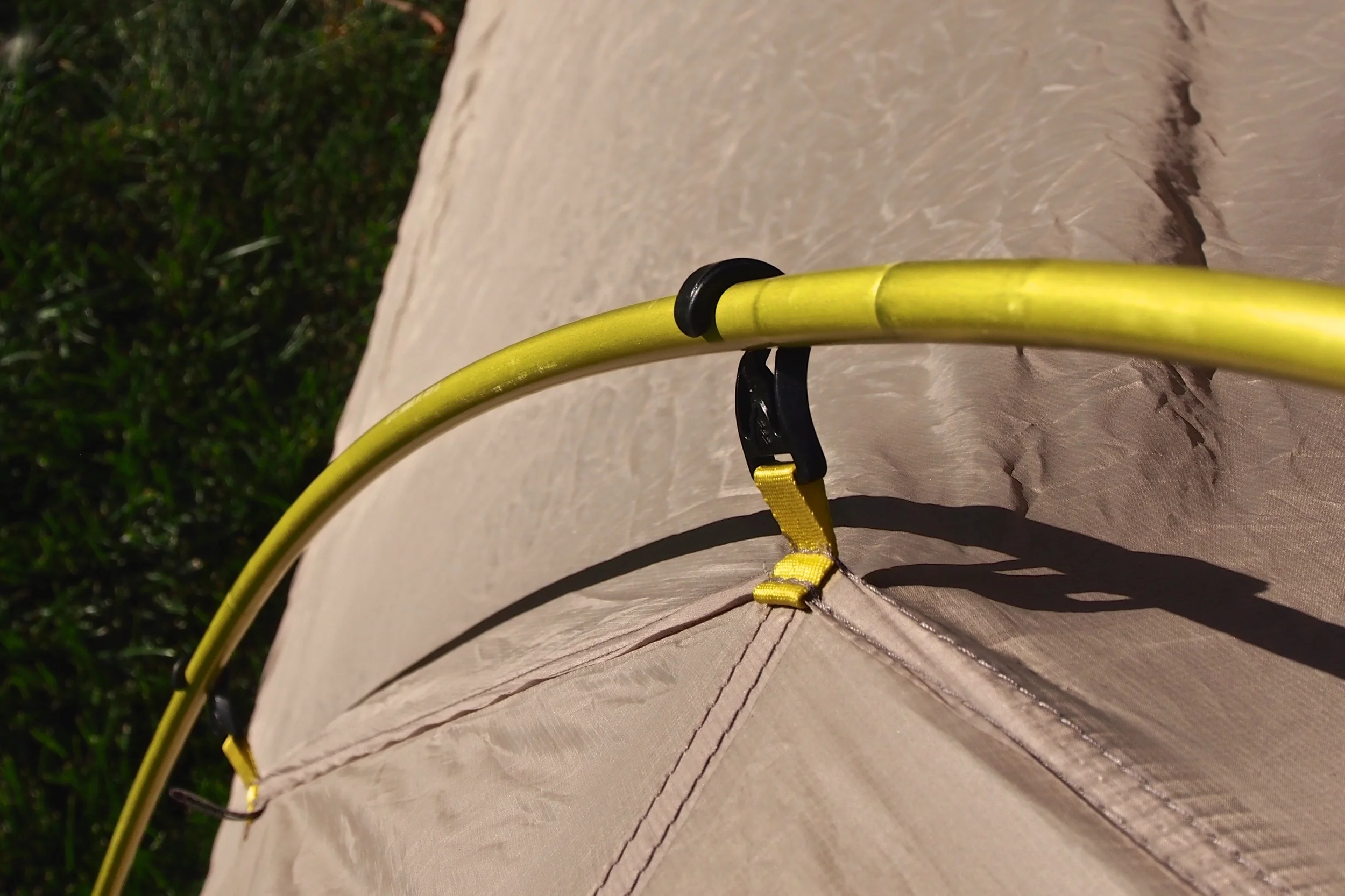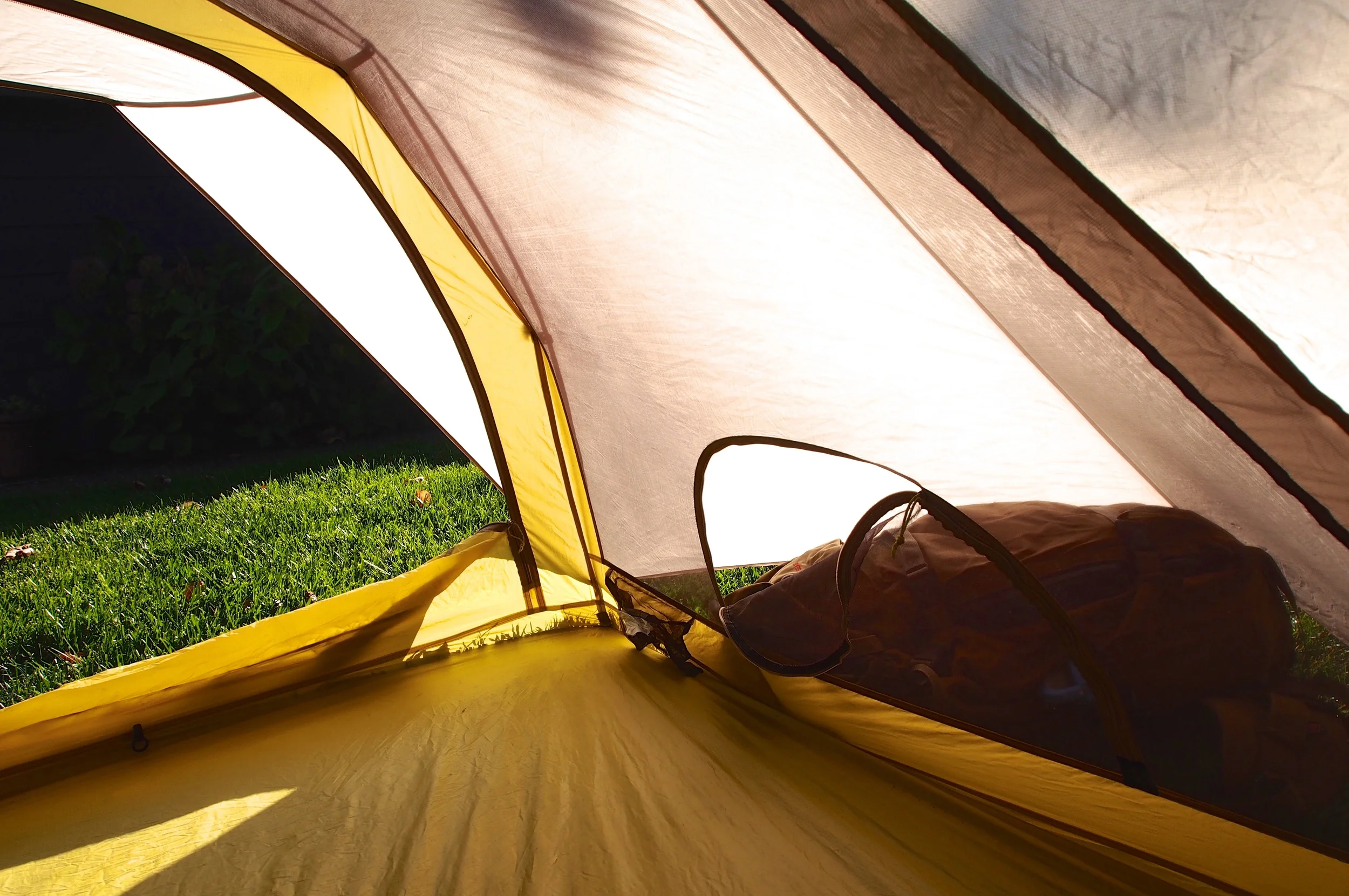Sierra Designs Lightning 2 FL
I’m not the world’s foremost expert on backcountry tents, but I know form and function when I see it. For years I dreaded the idea of tent camping because of how completely obnoxious a tent can be. Figuring out what poles go where, wrestling a rain fly on and off, and having to crawl through a vestibule just to get in and out of the tent was not my idea of a good time. If that wasn’t bad enough, I cringed at the way a tent would look once it was together. Most of the time, my tents always looked like a bikini model wearing a saggy set of drawers. The intention was great, but it just looked wrong. I had never once seen a tent set up in the field that looked like it did in the advertisement. To me, tents were pure evil so I often found myself making a bed in the back of my truck when I wished to go camping. That all changed when I decided I wanted to explore places that could only be reached by strapping on a backpack loaded with food and gear for a night or two. Thus began my search for the unholy of holy's…a tent.
At home in the Goat Rocks Wilderness in Washington State, the Lightning 2 FL is quick to pitch and easily pulls taut.
Pros:
- Easy to set up and get in and out of
- No wrestling a rain fly
- Roomy for 1, livable for 2
- Well under 4 lbs.
- Sturdy in the wind
Cons:
- Due to the design of the awning feature, it has two horizontal poles that are part of the tent fly. You cannot stuff this tent into a pack as you normally could without taking those poles out. For me, this is not an issue, but for some, it could be.
- Single layer fabric towards the back half of the tent can capture condensation and drip down inside onto a sleeping bag. Only an issue in wetter climates.
- For stargazing, this tent won’t do the trick because the fly and body of the tent are integrated as one.
When I found the Sierra Designs Lighting 2 FL, I immediately knew it best suited for what I was looking for; it was well under 3.5lbs., and a straight forward set up, easy to enter and exit, and fairly priced. I’m not an ultra-light guru who counts every ounce (okay...I may lean that way), but I certainly don’t want to carry in more weight than what I have to. To be honest, I think the thing that sold me on this tent was the fact that I wouldn’t have to wrestle with a vestibule or rain fly. The rain fly on the Lighting 2 is built into the body of the tent and the vestibules are removed to the sides of the tent making the entrance incredibly easy to get into. Once inside, you can access the vestibules on the side via a zippered opening that allows you to shuttle items in and out of the tent with ease.
The Lightning 2 FL is roomy for one average sized backpacker and livable for two. The back half of the tent body is a single layer which means there is no secondary barrier between you and the outside. At times this means you may experience some condensation but by ventilating properly, it can certainly be avoided or significantly reduced. If enough condensation accumulates, it can have a tendency to drip down and land on a sleeping back or pad but it's rarely enough to cause much concern.
The interior of the Lightning 2 FL has an internal peak height of 42.5 inches and just over 30 square feet of space making it a great option as solo shelter.
I purchased the tent with the intention that I would be rolling solo in it. I’m 5’8” and fit inside splendidly. I can sit up without brushing my head on the ceiling and can move around without feeling cramped. I often bring a lot of my belongings inside with me and have no issues with space.
As for living in the tent with two people, it actually does pretty well. Don’t get me wrong, it’s not a king size bed in there by any means, but two average sized people are able to move around easily without knocking our elbows and heads together. To top it off, on a recent trip, my wife and I had our 30lbs dog with us and were able to make it work (he slept on her sleeping pad…).
The guy line design pictured here allows you to pitch the tent and go back around to each guy line for further tensioning. This aids in setting the tent taut and is by far my favorite feature of the Lightning 2 FL. No repositioning of stakes needed.
The awning feature is icing on the cake. Being from the Pacific Northwest, I was hesitant about how this design would hold up in the rain and was pleased to see that it did so well. The only thing to keep in mind is that you should consider setting up the tent in such a fashion that you’re not receiving gusts of wind blowing headlong into the opening of the tent. If you point the aft end of the tent toward where you think the wind will blow you’ll be fine.
I’ve camped in this tent 4 -6 times over the course of the 2015 summer and cannot say enough good things about it. For a solo inhabitant, it’s incredibly roomy, takes just a few minutes to set up, is lightweight, and well designed. Having the both the body and the fly become one makes setting up the tent in the rain a relaxing experience because you don’t have to worry about the interior becoming soaked before you have the opportuniy to put the fly on. The tent is stable in the wind and is easy to set taut due to the way the tent is anchored to the ground. This means no saggy bikini bottom look.
Pictured above is another example of the external pole design of the Lightning 2 FL. Two of these hub designs are attached to the rain fly, one at the front of the tent and one at the aft. Stake your corners, assemble the poles, attach these hubs to the poles, and start clipping everything in. Quick and easy with no confusion.
With the rain fly being connected to the main body of the tent as one unit, you'll see that the tent poles are now on the outside of the tent. This creates a ridiculously easy way to pitch the tent quickly without soaking the interior if you happen to be pitching in the rain. Easy on and easy off clips like the one pictured above makes life that much easier when setting up or breaking down camp.
The Lightning 2 FL has a great awning feature that is created by this horizontal beam that is built into the tent fly. To pack the tent down into a ball, you would have to remove these beam which is easily accomplished.
At this point in my backpacking life, this tent is fulfilling all of my needs as a solo tent and I think it’s going to be difficult for me to go back to a traditional style tent with vestibules in front of the entrance that go down to the dirt and a separate rain fly.
Vestibules are removed to the side of the tent meaning no more crawling over gear when entering or exiting the tent. Access to the vestibules is easily accomplished by two half-circle zippers on either side of the tent as picture above.
If you’re looking for a fresh design and are willing to make the jump to a vestibule-less tent (or a redesign of where the vestibule is located), I say you’ll be more than pleased with this product.
If you have used this tent as well, I’d love to hear about it.
P.S. I was able to purchase this tent through on sale at about 40% off which meant I picked it up for around $200.
By Land,
Emory Ronald
The Lightning 2 FL in full view of Mount Adams on the Loowit Trail of Mount St. Helens. Photo courtesy of Tabi Evans








